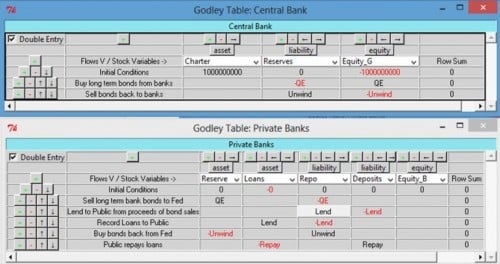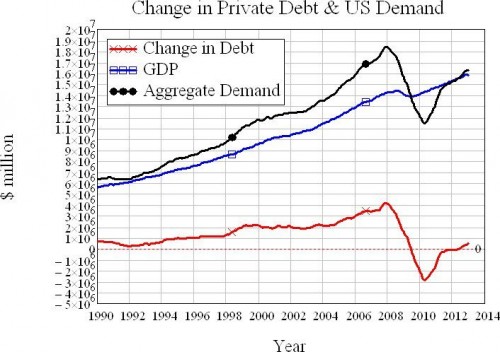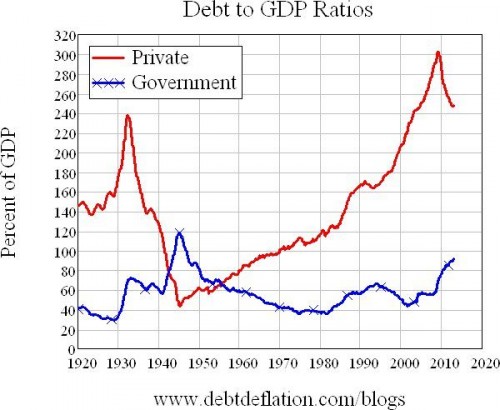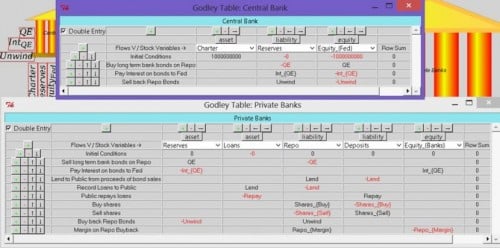How QE works and what this means for asset prices and credit
By Steve Keen
America is a land of contention, and one of the most contentious topics here (I’m in Seattle as I write) is the impact of the Federal Reserve’s policy of “Quantitative Easing” – otherwise known as ‘QE’. The Federal Reserve has committed to spending $85 billion every month buying a wide range of bonds from banks, until such time as the US unemployment rate falls below 6.5 per cent.
The Fed has implemented this policy because it believes it is the best way to stimulate demand in a depressed economy. Its critics oppose it because they believe this massive amount of ‘money printing’ must inevitably lead to ruinous inflation.
I reckon they’re both wrong, and in a seriously wonky post I’ll try to explain why, using my modelling program Minsky.
Minsky develops a model of monetary flows using double-entry bookkeeping – which is the same way that banks run their businesses – so it’s a powerful way to cut through the confusion over what actually happens in QE. But double-entry bookkeeping can make your head spin because it involves lots of ALE – and unfortunately not the fun intoxicating kind, but the boring accounting trio of Assets, Liabilities and Equity.
The heart of accounting is the principle that the difference between the debts other people owe to you (your Assets) and the debts you owe to them (your Liabilities) is your net worth (your Equity). This is drummed into accounting students as the “Fundamental Equation of Accounting”: “Assets equal Liabilities plus Equity”.
Double-entry bookkeeping (DEB for short) enforces this equation in two ways. Firstly, it records any Asset as a positive amount, and Liabilities and Equity as negative amounts. Secondly, it ensures that any transaction between accounts sums to zero. So, for example, if a rich aunt died and left you $1 million in her will, your accountant would show that as your Assets changing by plus $1 million and your Equity changing by minus $1 million. It sounds counter-intuitive when you first learn it, but it works to make sure you don’t make mistakes when tracking financial transactions.
Minsky uses a similar approach: Assets are shown as positive sums, so assets are increased by adding to them – no big deal there. But Liabilities (and Equity) are shown as negative sums, so increasing a Liability involves subtracting from it (is your head spinning yet?). So a loan of $1,000 from a bank is recorded as plus $1,000 in its loan account – an increase in its Assets – and as minus $1,000 in your deposit account – an increase in its Liabilities to you. The sum across the row that records the transaction is zero.
Then Minsky assembles a model of financial flows from the economy’s point of view, in which everything is shown as a positive – just as the Federal Reserve does when it compiles its Flow of Funds record of the entire economy.
Boy, I’ve probably lost half my normal audience already – and probably to Ales of a different kind. But if the rest of you have survived that intro, let’s plug on and build a model of QE.
A model necessarily involves simplifications – otherwise you’d have a replica, not a model – and I’m using an extremely simple vision of a Central Bank. Firstly to acknowledge that it has an unlimited capacity to create money if it wants to, I’ve said that it has an Asset called a ‘Charter’ that lets it create as much money as it wants to. Then to balance its books following DEB, I’ve given it an Equity account that I label “Equity_FED” (for “Equity of the Federal Reserve”), and I’ve endowed this with an initial value that is the negative of the value of its Charter.
That leaves its liabilities to model, and as ‘the banker’s bank’ the Fed’s key liabilities are the deposits accounts of private banks – which economists call Reserves. Just to simplify the model, I set these as zero to begin with. So my model of the Fed in Minsky starts off looks like this:
Figure 1: The Fed’s balance sheet before QE
Next we have to model the private banks. I’m lumping them all together here (Minsky can handle modelling multiple private banks, but that’s not needed for this simple model), and giving them five accounts: two Assets, two Liabilities, and their Equity (Equity_B).
Their Assets are the Reserves they hold at the Fed, and the Loans they make to the public. Their Liabilities are the Deposits the public has with them, and another account I’m calling “Repo”.
Why Repo? Because when the Fed buys bonds off the banks, it normally does so in what is known as a “Repurchase Agreement” (or “Repo” for short): it buys a bond at one price and agrees to sell it back at another price at a future date. QE works the same way, but without a fixed date for selling the bond back. Figure 2 shows the private banks’ collective balance sheet before QE.
Figure 2: Private banks’ balance sheet before QE
Now enter QE. The Fed buys bonds off the private banks by transferring money from its essentially limitless Equity account. Following the rules of DEB, this is shown as a plus QE on its Equity and a minus QE on the Reserves of private banks: the liability the Fed owes to them has risen.
That’s seeing it from the Fed’s point of view. For the private banks, their Assets have risen by the amount QE. But they also have a liability: they have to buy the bonds back off the Fed whenever the Fed wants them to do so. For this reason, and to obey DEB, exactly the same amount has to turn up on Liabilities (and Equity – since the banks will make a profit out of this transaction by buying the bonds back for less than they sold them for – but for simplicity I’m ignoring this aspect for now). Figure 3 shows QE from the banks’ perspective: their assets have risen by QE (the Reserves liability of the Fed is an asset for the private banks), and they have a liability to the Fed of QE.
Figure 3: QE from the private banks’ point of view
QE is colloquially called ‘printing money’, and the fear that critics have about QE is that it’s going to dramatically increase the money supply and cause runaway inflation. But up to this stage in the model, QE has done nothing at all to the money supply.
That’s because, in a nutshell, the money supply that ticks over on Main Street and Wall Street is the sum of the liabilities of the banking sector to the rest of the economy, plus the money the banks have earned from their activities. In this simple model, this is the sum of Deposits plus Equity_B. So far, QE has done nothing at all to either. (In fact the banks could book the gain they expect to make from QE as part of their equity, but as noted I’m initially ignoring this detail in this simple model.) If QE is going to affect the money supply, then the banks have to lend from it to the public.
They can do so from the Repo account – so the next stage of the model shows them doing just that, with the flow Lend (see Figure 4). The banks have an incentive to do this, since the return they get on their Reserves from the Fed is a lot lower than they could get from the public (of course there are also good reasons not to lend, which I’ll get on to later).
Figure 4: The banks use QE to lend to the public
But this can’t be the end of it, because thus far the banks have lent money without recording the loan. So how do they do that? The loan to the public creates an asset for the banks (which must be shown as a positive), and this has to be matched by an increase in their liabilities as well (which must be shown as a negative). The next row shows this operation (see Figure 5).
Figure 5: Banks record the loans to the public
Notice what this does to the Repo account: the original lending from Repo is cancelled out by recording the loan! The net effect is just the same as if the banks had ignored QE and just lent to the public directly – creating assets on one side of their ledger (Loans) and liabilities on the other (Deposits). QE is actually quantitatively irrelevant to this operation.
Figure 6 completes the model by including repayment of loans by the public, and the (eventual) unwinding of QE by the Fed. It lets us work out the quantitative impact of QE on the money supply and the answer is – absolutely nothing. Nada. Zip. They money supply will expand if lending by private banks exceeds repayment of debt by the public, but quantitatively, QE is nowhere to be seen.
Figure 6: The full model including loan repayment and unwinding QE
QE could influence the money supply if it drove up lending by banks by increasing the margin between lending and deposit rates (which would make lending more attractive to banks), or by lower lending rates encouraging more borrowing by the public – and that in fact is what the Fed is hoping that QE will achieve (forlornly, in my opinion – which I’ll get to in a minute). But though it dramatically increases the Reserves of the private banks, it does nothing to directly increase the money supply.
So the ‘printing money’ moniker that critics give to QE is misguided: it actually creates no additional money at all (outside of the gain banks will make on the repo deal). For money to really be created, QE would have to go directly to the Deposits of the public in the private banks, and that’s not what QE does. ‘Printing Money’ is therefore a false model: it implies that Ben Bernanke is printing greenbacks and mailing them in little brown envelopes to everyone on Main Street, and that’s not even close to how QE operates.
But the critics of QE aren’t the only ones operating with a false model: so is the Fed. I’m sure that Bernanke knows that QE isn’t creating additional money, but he believes that it will reduce interest rates and thus encourage more lending by the private banks, which would stimulate demand. He sees no problem with more debt being taken on by the public, since he thinks that the level of private debt has no impact – good or bad – on the economy. From his “New Keynesian” point of view, a loan is simply a transfer from a saver to a borrower, and, as he put it in 2000: “Absent implausibly large differences in marginal spending propensities among the groups … pure redistributions should have no significant macro-economic effects…”
That’s where the neoclassical blindspot about banks gets in the way (‘New Keynesians’ like Bernanke and Paul Krugman are in fact a subset of the dominant sect in economics known as ‘neoclassical economics’). They imagine that lending by banks is just like lending between private individuals: if I borrow money from, say, John Carlson, then John’s spending power goes down and mine goes up – one largely cancels the other, and the net effect on macroeconomics will be just the difference between my propensity to spend and John’s, which will be a minor factor. They therefore argue that aggregate demand equals income alone, and the change in private debt can be ignored.
But lending from a bank isn’t like that: if a bank lends me money, then my spending power goes up without reducing anybody else’s. So bank lending is not simply a “pure redistribution”: it instead creates new money, and adds to demand when it is spent. From this perspective, aggregate demand is income plus the change in debt. (I get accused of double-counting here – I’ll explain why that’s not the case in another post.)
As I’ve explained at length before, this is why ‘the Great Moderation’ occurred – because Americans borrowed up big from 1993 till 2008, increasing private debt from $10 trillion to $40 trillion when GDP rose from $6 trillion to $14 trillion. It’s also why ‘the Great Recession’ occurred – because when Americans stopped borrowing and instead started to reduce their debt, demand (for both goods and services and assets like houses and shares) collapsed.
Figure 7: Aggregate demand collapsed when the growt of private debt stalled and turned negative
So contra Bernanke’s belief that the aggregate level of private debt doesn’t matter, it matters a great deal. That in turn means that Americans are very unlikely to spend more because of QE, because they’re already straining under a level of private debt that is unprecedented – even after several years of deleveraging, the level of private debt compared to GDP is higher than it ever was during the Great Depression.
Figure 8: America’s debt to GDP ratios since 1920
Lower interest rates therefore aren’t going to be a great enticement to Americans to borrow money from banks (or each other). They may do a bit more borrowing—especially if the Fed’s actions have spurred rallies in asset markets, which I consider below—but this is likely to run out of steam pretty quickly.
So QE isn’t going to cause The Great Inflation as some of its critics fear, but nor is it going to restore normal economic activity, as Bernanke appears to hope it will. However it’s not “mostly harmless” either: it could well be guilty of another charge critics throw at it, of artificially inflating asset markets in a way that could lead to market crashes when it is unwound. Considering this issue involves making my Minsky model of QE a bit more complicated—so if you’ve had enough of accounting ALEs for one day, skip the rest and go drink a real one. If you’ve got this far, you deserve one.
Complexities
I ignored some extra issues in the above analysis that could enable some of QE to enter the money supply. These include other uses that banks might make of the excess reserves (such as buying shares from the public), and the Repo margin that banks will ultimately make when they buy the bonds back from the Fed when QE is unwound. There’s also a factor in QE that could reduce the money supply too – payment of interest on bonds in QE. This is because QE is not like standard Repos which last as little as a day or week, so presumably the banks have to pay interest to the Fed since the Fed owns the bonds for an indefinite period.
I’m tentative about these additions – I’m open to correction that I’ve wrongly characterised what banks do or how QE works here. That said, this final model shows two ways that QE could actually increase the money supply: by banks being net buyers of shares (and other assets) from the public before QE is unwound, and by the net margin that banks will make once the Repo side of QE comes to fruition (and which they have probably anticipated to some degree and booked as profits already). So QE could increase the money supply, if (a) the banks are net buyers of shares while QE lasts and (b) they make a margin on the repo trade within QE.
Figure 9: QE with share trading and Repo margin
Putting this all together, the net quantitative effect of QE on the money supply comes down to net buying by banks of shares (and other assets) from the public, and the difference between the Repo margin the banks make on QE and the interest they (presumably) have to pay to the Fed while QE lasts. There can also be a price effect – which is all that Bernanke really appears to be targeting – of lower interest rate costs spurring more borrowing by the public, so that net borrowing (the difference between ‘Lend’ and ‘Repay’ in my model) is larger than it would have been without QE.
All that results in this equation (generated by Minsky) for change in the money supply:
Of those factors, the largest is likely to be net buying of shares by banks while QE lasts. If this logic is in the ballpark of what banks are actually doing, then this puts flesh on economist Michael Hudson’s remark that “Bernanke’s helicopter is dropping money on Wall Street, not Main Street”, and on fears that QE is helping drive a stock market bubble. The reaction of the stock market to fears that Bernanke might start to unwind QE this year could therefore be well founded.
Confession
Here I have a confession to make: I am not, and never have been, an Accountant. I didn’t even study it at University: though obviously I studied Economics, I did so as part of an Arts/Law degree, and thus avoided the dry and dusty topic of DEB (double-entry bookkeeping). I’ve only belatedly come to appreciate its importance in understanding our monetary economy too – my earliest academic work on money ignored DEB – but I hope now I’ve atoned for my sins of omission.
This post was originally published on Australia’s finance news publication Business Spectator
Steve Keen is author of Debunking Economics and developer of the Minsky software program.










Comments are closed.